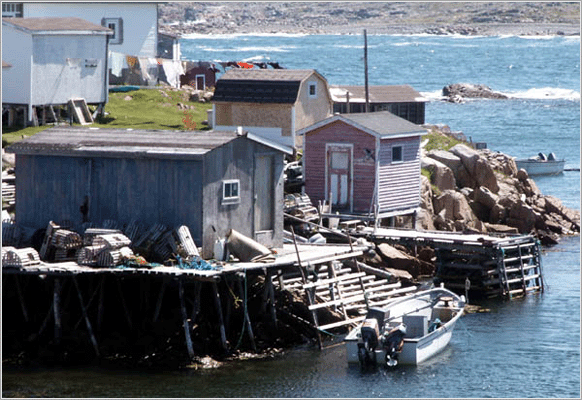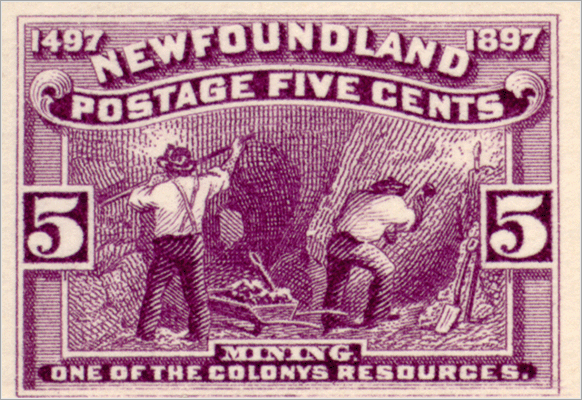Living in Canada:
Newfoundland & Labrador
Overview
 A Newfoundland fishing outport
A Newfoundland fishing outport
Newfoundland and Labrador has long been known in legend and myth around the world as one of the most spectacular natural regions on earth. It can be said that it was the first site for Canadian Immigration, in Canada. It was first visited by the Vikings almost 600 hundred years before the arrival of Christopher Columbus in 1492. As you can see, immigrants have been visiting Newfoundland for a very long time.
The Province consists of the island of Newfoundland and the mainland Labrador, on Canada's Atlantic coast. On entry into Canada in 1949, the entire province was known as Newfoundland, but since 1964, the province's government has referred to itself as the "Government of Newfoundland and Labrador", and on December 6, 2001, an amendment was made to the Constitution of Canada to change the province's official name to "Newfoundland and Labrador".
In general day-to-day conversation, however, Canadians still refer to the province in a general way as "Newfoundland," while the Labrador region of the province is usually referred to as simply Labrador.
While the name "Newfoundland" is derived from English as "New Found Land", Labrador is named after Portuguese explorer João Fernandes Lavrador.
The province's population is 514,536 according to the 2011 national census. People from Newfoundland are called "Newfoundlanders" (and at times "Newfies", though this can be seen as a pejorative) while people from Labrador are called "Labradorians". Newfoundland is a warm and friendly society that welcomes immigrants from around the world. It has its own dialects of the English, French, and Irish Gaelic languages. The English dialect in Labrador shares much with Newfoundland. Furthermore, Labrador has its own dialects of Innu-aimun and Inuktitut.
Geography
As well as the long border on the mainland with Quebec on the Labrador peninsula, the province has a short border with Nunavut on the small Killiniq Island, ending at Cape Chidley. All islands off the northern coast of Quebec belong to the territory of Nunavut.
Newfoundland also shares a territorial water border with France, with the islands of Saint-Pierre and Miquelon.
| Ethnic origins | |
|---|---|
| Ethnic origin | Percent |
| English | 39.4% |
| Irish | 19.7% |
| Scottish | 6.0% |
| French | 5.5% |
| First Nations | 3.2% |
Immigration Profile
The Canada 2011 Census counted an estimated 92,990 foreign-born people in the four Atlantic provinces combined. This was an increase of 84,800 immigrants from 2006. Newfoundland and Labrador attracted 9,165 of the new Canadian immigrants. Unlike the other Atlantic provinces, the United Kingdom was the top source country for Newfoundland and Labrador.
The Economy
 1897 Newfoundland postage stamp, the first in the world to feature mining
1897 Newfoundland postage stamp, the first in the world to feature mining
Hibernia clearly made a very significant contribution to the provincial economy in 1998, and exploration and work on other projects means that the offshore oil industry's contribution was even greater.
Newfoundland and Labrador has posted the strongest economic growth of any maritime province in 2012, though it has the highest ratio of job-seekers in the country.
Economic gains were broadly-based and included increases in offshore oil production, crab and shrimp landings, construction activity, tourism and manufacturing.
Education
Newfoundland and Labrador is an excellent place to live and study. Situated on the northeast corner of North America, the spectacular natural setting of our province provides a beautiful backdrop for you to pursue your educational goals. With one of the lowest crime rates in North America, affordable housing and education, and a distinctive, friendly culture, our province offers quality of life beyond expectation for those considering Immigration to Canada. The unique blend of historic charm and exciting modern living makes Newfoundland and Labrador, Canada an amazing place to live.
The province's public post-secondary institutions consist of Memorial University of Newfoundland and the College of the North Atlantic. There are also a number of privately operated, government regulated Career Colleges throughout the province.
With state-of-the-art facilities, excellent research and development opportunities, internationally recognized programs, and respected and approachable faculty, Newfoundland and Labrador's post-secondary education institutions are preparing graduates for careers around the world.